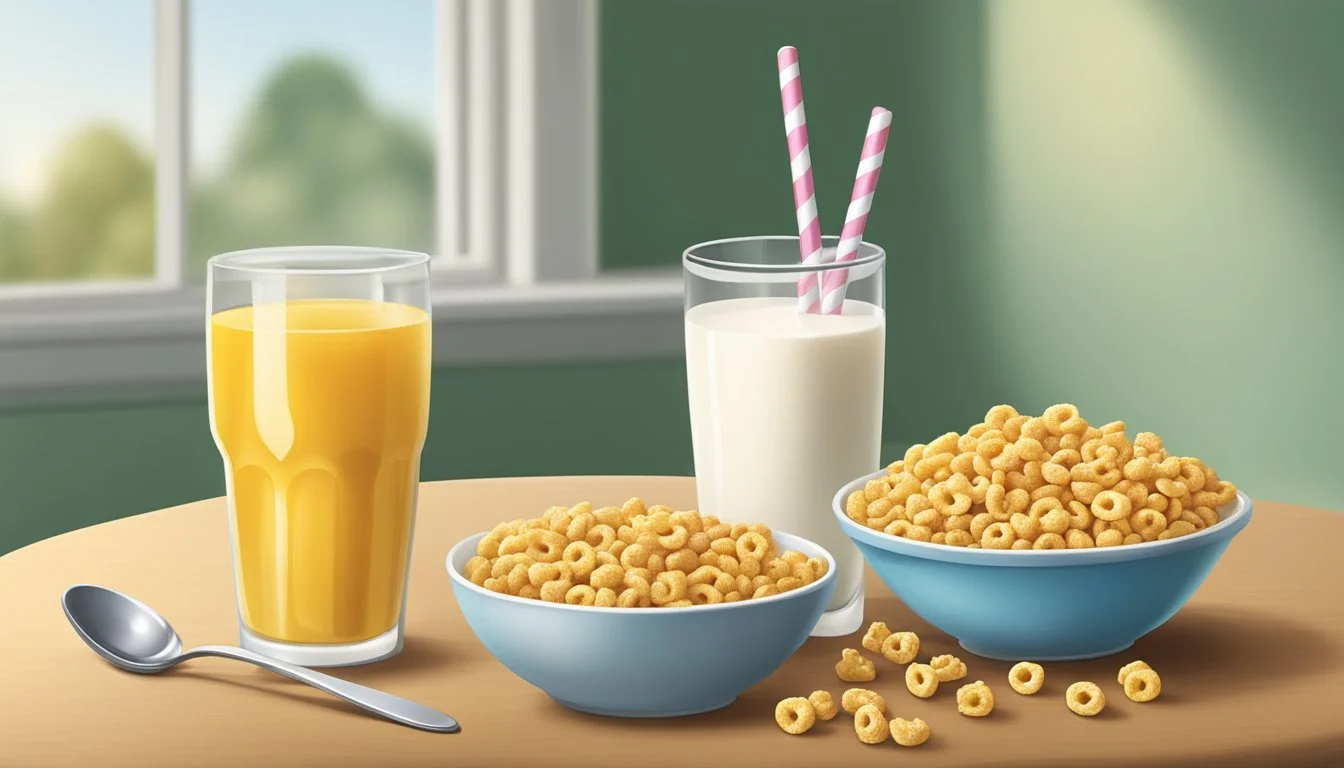Corn Pops vs Honey Nut Cheerios
A Nutritional Comparison
This Article is Part of Our Breakfast Cereal Guide with Details on Corn Pops Nutrition and Honey Nut Cheerios Nutrition
When navigating the breakfast aisle, two cereals often catch the eye: Corn Pops and Honey Nut Cheerios. Corn Pops offers a sweeter and crunchier experience, making it a favorite among those who crave a sugary kick to start their day.
Honey Nut Cheerios, on the other hand, balances sweetness with a hint of nuttiness and comes with healthful perks. Rich in dietary fiber and made with whole grains, Honey Nut Cheerios can be a healthier option, especially for those mindful of their nutritional intake.
Choosing between Corn Pops and Honey Nut Cheerios can hinge on personal preferences for taste and health considerations. Readers will find that understanding the subtle differences in nutritional content and flavor profiles can help them make a more informed breakfast choice.
Comparative Analysis of Corn Pops and Honey Nut Cheerios
When comparing Corn Pops and Honey Nut Cheerios, several key factors such as nutritional profile, taste, and ingredient composition come into play. This section will explore these aspects to provide a comprehensive understanding of the differences between these two popular cereals.
Nutritional Profile
Serving Size and Calories: Corn Pops offers a standard serving size of 1 cup, equating to 110 calories per serving. In contrast, Honey Nut Cheerios also provides 110 calories per ¾ cup serving.
Macronutrients: Corn Pops contains 1 gram of protein, 0 grams of fat, and 90 milligrams of sodium per serving. Honey Nut Cheerios provides 3 grams of protein, 1 gram of fat, and 250 milligrams of sodium per serving.
Nutrient Corn Pops (1 cup) Honey Nut Cheerios (¾ cup) Calories 110 110 Protein (g) 1 3 Fat (g) 0 1 Sodium (mg) 90 250
Micronutrients: Honey Nut Cheerios come fortified with various vitamins and minerals, including iron and vitamin D. Corn Pops also contain added vitamins and minerals, making both cereals a source of essential nutrients.
Taste and Flavor Variety
Corn Pops: Known for its mildly sweet, corn-flavored taste, Corn Pops appeals to those who prefer a less intense sweetness. Its crispy texture remains consistent in milk, delivering a satisfying crunch.
Honey Nut Cheerios: Honey Nut Cheerios has a distinct honey and nut flavor, offering a sweeter taste profile than Corn Pops. This cereal's sweetness appeals to those with a preference for a more pronounced flavor experience. The toasted oat base contributes to its unique texture.
Flavor Varieties: Honey Nut Cheerios also has several variations, such as Oat Crunch, which includes honey, almond, cinnamon, and berry flavors. Corn Pops typically stick to their classic formula without extensions into additional flavor segments.
Ingredient Composition
Primary Ingredients: Corn Pops primarily uses milled corn, sugar, and corn syrup, contributing to its characteristic taste. Honey Nut Cheerios contain whole grain oats as the main ingredient, along with sugar, honey, and almond flavoring.
Sweeteners: Corn Pops use corn syrup and cane sugar, while Honey Nut Cheerios incorporate cane sugar and honey. The difference in sweeteners contributes significantly to their flavor distinctions.
Additives and Preservatives: Both cereals contain added vitamins and minerals for fortification. Corn Pops may include more preservatives to maintain shelf-life, whereas Honey Nut Cheerios focus on ingredients like modified corn starch and tripotassium phosphate.
Summarizing these factors, Corn Pops leans towards a simpler, corn-based sweet cereal, while Honey Nut Cheerios provides a richer, more complex honey-nut flavor profile with higher protein content.
Health Considerations
Corn Pops and Honey Nut Cheerios present distinct health profiles, each with specific dietary benefits and downsides. Analysis of their nutrient content provides insights into making informed choices for a healthy breakfast.
Dietary Benefits and Downsides
Corn Pops, made by Kellogg's, feature low fat content, with no grams of fat per serving. They also contain 110 calories and 1 gram of protein per serving. One downside is their relatively low fiber content which contributes less to daily fiber intake as recommended by the FDA.
Honey Nut Cheerios, produced by General Mills, have a slightly higher nutrient profile. They contain 1 gram of fat, 3 grams of protein, and 110 calories per serving. Unlike Corn Pops, they provide 2 grams of fiber, which aids in digestive health. The inclusion of whole grain oats offers additional health benefits, including the potential to lower cholesterol.
Sodium content is significantly higher in Honey Nut Cheerios, with 250 mg per serving compared to 90 mg in Corn Pops. This is an important consideration for those monitoring their sodium intake to maintain heart health.
Recommended Intake
The recommended serving size for Corn Pops is 1 cup, while Honey Nut Cheerios have a suggested serving size of 0.75 cups. Despite the different serving sizes, both cereals offer similar calorie counts per portion.
For those looking to meet daily nutrient needs, Honey Nut Cheerios provide a better balance due to their higher protein and fiber content. Yet, the increased sodium level in Honey Nut Cheerios must be monitored, especially in individuals requiring lower sodium intake.
Both cereals can be part of a healthy diet when consumed in moderation and balanced with other nutrient-rich foods. Paying close attention to serving sizes and the nutritional content can help ensure these cereals contribute positively to overall dietary goals.
Market Comparison with Other Cereals
The comparison between Corn Pops and Honey Nut Cheerios extends beyond their nutritional content, branching into how they stand in the broader market. This includes their competition with other cereals and their pricing and consumer popularity.
Cereal Alternatives
When evaluating Corn Pops and Honey Nut Cheerios, it’s essential to consider how they compare to other popular cereals such as Cinnamon Toast Crunch, Raisin Bran, and Lucky Charms. Each of these cereals offers unique flavors and nutritional profiles.
For example, Froot Loops and Rice Krispies are often sought after for their taste and versatility. In terms of nutritional value, Honey Bunches of Oats offers more protein and fiber, which may appeal to health-conscious consumers. Comparing these cereals gives a broader context for understanding the market placement of Corn Pops and Honey Nut Cheerios.
Price and Value
Price sensitivity is vital. Corn Pops and Honey Nut Cheerios are often priced competitively at major retailers like Walmart and Target. A comparison table highlights the price variations among popular cereals:
Cereal Average Price per Box Servings per Box Corn Pops $3.50 12 Honey Nut Cheerios $3.80 10 Frosted Flakes $4.00 14 Cinnamon Toast Crunch $3.60 10 Special K $4.25 11
Examining the price and servings can help consumers gauge which cereal offers the best value for their money. Corn Pops might be more economical, while some might opt for Honey Nut Cheerios for its taste and additional nutrients despite a slightly higher price.
Consumer Preferences
Consumer habits and preferences play a crucial role in the popularity of cereals. Both Corn Pops and Honey Nut Cheerios have strong followings. Voting results and customer reviews frequently highlight the preference for Honey Nut Cheerios due to its sweet taste and perceived health benefits.
Mini Wheats and All-Bran appeal to those seeking high fiber content. Conversely, Cocoa Puffs and Cap’n Crunch are favorites among children due to their chocolatey and sugary content. The appeal of different cereals such as Life, with its balanced sugar and health benefits, often reflects broader consumer trends in dietary preferences.
This variance in preferences underscores why both Corn Pops and Honey Nut Cheerios retain significant market shares, catering to diverse consumer needs and tastes.
Brand Analysis
The competition between Corn Pops and Honey Nut Cheerios brings into focus their unique brand identities and market positions. This comparison highlights the strategic moves and historical evolution of each brand.
General Mills' Market Position
General Mills holds a notable position in the cereal market, particularly with its Honey Nut Cheerios. This product line has been a strong performer, accounting for 16.2% of General Mills' total U.S. cold cereal sales. Its popularity can be attributed to both its sweet taste and nutritional benefits, such as 3 grams of protein per serving.
In recent years, General Mills has also focused on promoting health-conscious choices, which has helped maintain their competitive edge. Their marketing strategies often emphasize the heart-healthy benefits of Honey Nut Cheerios, appealing to a wide demographic. With consistent market engagement, General Mills effectively leverages its brand reputation.
Corn Pops Brand Evolution
Corn Pops, manufactured by Kellogg's, has undergone several transformations since its introduction. Initially released as Sugar Corn Pops, the brand has rebranded several times, reflecting changing consumer preferences towards lower sugar content. Corn Pops still retains its distinctive flavor and light, crunchy texture.
Despite facing stiff competition from other cereals, Corn Pops maintains a loyal customer base. Today, a serving of Corn Pops is consistent, offering 110 calories and 1 gram of protein. Kellogg's has positioned Corn Pops as a nostalgic treat while subtly updating its nutritional profile over the years. The brand continues to evolve to match contemporary consumer expectations for healthier breakfast options.
Environmental and Ethical Implications
Corn Pops and Honey Nut Cheerios have different impacts on the environment and ethical considerations.
Organic and Sustainable Practices
Honey Nut Cheerios, which primarily contains oats, can be beneficial for the soil when oats are planted as cover crops. This practice helps to improve soil health and reduce the need for chemical fertilizers.
Corn Pops, on the other hand, is made from corn, which often requires significant pesticide and water inputs. This can lead to negative environmental effects.
Environmental responsibilities also differ between companies. General Mills, the manufacturer of Honey Nut Cheerios, has shown a commitment to reducing pesticide levels and sourcing ingredients sustainably.
In contrast, Kellogg's, the producer of Corn Pops, may not focus as heavily on these practices, affecting their overall environmental footprint.
Consumption Trends and Patterns
The consumption patterns of Corn Pops and Honey Nut Cheerios reveal a significant shift towards varied breakfast habits and consumer preferences. This analysis highlights the changes in breakfast choices influenced by the nutritional content and popularity of these cereals.
Changing Breakfast Habits
Breakfast routines have evolved in recent years, reflecting the growing interest in healthier options. Honey Nut Cheerios has seen a 41.84% increase in popularity, according to recent data.
Consumers are also pairing cereals with diverse foods, such as Oreo, Trix, and Pop Tarts. This indicates a trend toward mixing traditional cereals with novel items.
Corn Pops, while still a staple for many, hasn't exhibited the same recent growth in consumer interest. They continue to remain a familiar option, particularly appreciated for their sweet flavor.
The consumption frequency of Honey Nut Cheerios and Corn Pops shows the balancing act between taste preference and nutritional value.
More on Corn Pops
More on Honey Nut Cheerios
Cinnamon Toast Crunch vs Honey Nut Cheerios: Which is better?
Honey Nut Cheerios vs Kellogg's Apple Jacks: Which is better?
Honey Nut Cheerios vs Kellogg's Froot Loops: Which is better?
Honey Nut Cheerios vs Post GrapevsNut Flakes: Which is better?
Honey Nut Cheerios vs Post Raisin Bran Cereal: Which is better?





